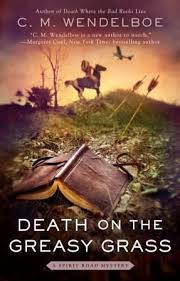Death on the Greasy Grass (2013) by C. M. Wendelboe. Recommended.
This title is part of a series called ‘Spirit Road’ set in Montana among the contemporary Lakota, Cheyenne, and Crow peoples and the Europeans and Asians who now populate that part of the world. The protagonists are an FBI Agent Emmanual Tanno a Lakota by birth and his long time friend and fishing buddy Police Chief Willie Deer Slayer, a Crow. It is a police procedural set among rolling pastures of a thousand acres, cowboy bunk houses, horse auctions, and the Big Sky of Montana. Once seen there is nothing else to call it but Big Sky.

When an artifacts dealer is killed by accident in a re-enactment of Custer’s Last Stand at the Little Big Horn which the victorious Sioux called the Battle on the Greasy Grass, there is more to it than at first meets the eye. Manny comes from an ancient line of Sioux Spirit Walkers, but as a modern and educated man he rejects all that tribal mumbo-jumbo, and yet … he sometimes sees things that others, not even Willie standing right there with him, do not see.
The plot is convoluted enough to retain interest, and the drunken sot Sam Star Dancer is full of surprises. Aspiring senator Wilson Eagle Cloud is too good to be true, or is he? As beautiful as Cheona Star Dancer is, the closer Manny gets to her the more he senses the glacial, calculating cold in her being. Jim Hawkins is a world class bully, and the elusive Carson Degas is a murderous thug. All in all a nice cast of prospects and suspects to keep any investigator investigating.
Willie’s shooting is an appealing human drama as is the vexation of his fiancée and Manny’s wife with all those damn guns these crazy Indians have.

The spirit mysticism fades from the story in the last one hundred pages and the final shoot out seems by-the-numbers.
I found the first fifty pages tedious before the action started, and I was annoyed that so many of the characters had the same mannerisms, dutifully described, like chin-pointing or sucking chewing tobacco in the same way. That seemed to me to be the padding of an insecure author. But once the characters were in place and events began to move, these annoyances were less distracting. I never did quite understand what the early interspersed chapters from June 1876 had to do with the story. Nonetheless, I will certainly read another in this series.
Skip to content
